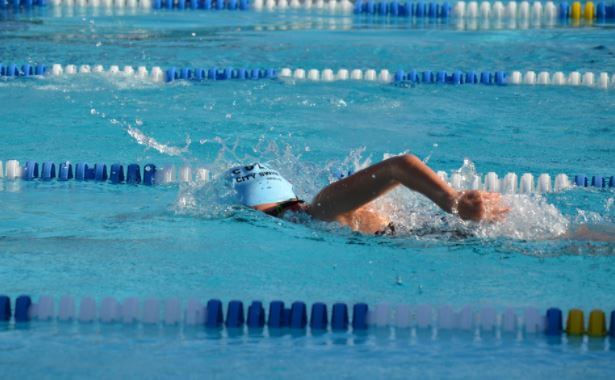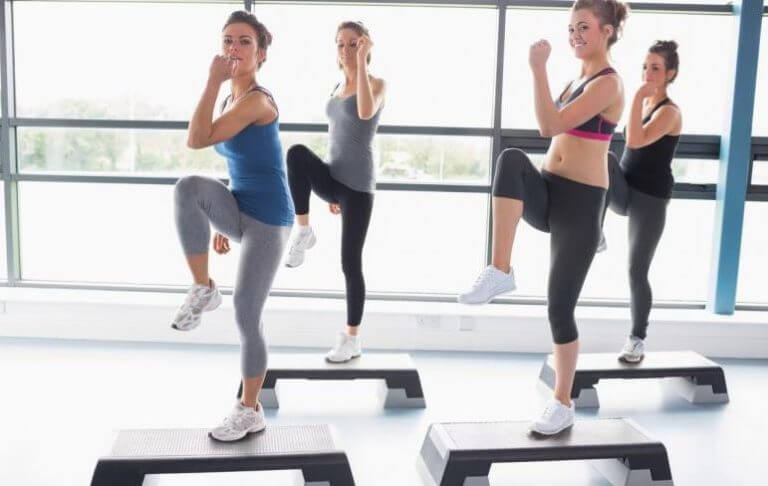8 Low-Impact Cardio Training Routines

Perhaps you think ‘doing cardio’ is for very fit people, or for people that have been training in the gym for a long time. But it’s actually possible to perform a low-impact cardio training routine while you’re still a beginner. We’ll tell you more about it in this article.
Low-impact cardio training: at your own pace
It doesn’t matter if you’ve never been to the gym or if you stopped going a long time ago. You can adapt your cardio training routine to fit your current situation, physical condition, and goals.
If you actually want to see results, don’t give up and don’t think of it as an obligation. We recommend that you start gradually, at your own pace and without setting impossible standards of effort.
The idea is that you enjoy working out, not that you have a bad time and lose any interest in putting on your gym attire. You don’t even have to sign up at an academy since you can totally exercise at home or in a park. There are lots of different options besides running!
Low-impact cardio training routines for beginners
It doesn’t matter what you choose to do, the important thing is that you get moving. With this in mind, you can choose almost any activity that you enjoy doing. If you don’t have a clear idea about which activity to choose, here are come cardio training options for beginners:
1. Swimming: the low-impact cardio par excellence
Swimming is one of the most complete sports out there, and the best part is that it’s also suitable for any age group. You can stick to just swimming or you can practice another water activity such as water aerobics.
The best part about this sport is that you won’t feel the impact on your knees or any other joint. Without even realizing it, you’ll be working your muscles in an amazing way.

2 Walking
If you’re trying to lose weight, doctors have probably advised you to ‘go for a walk’. You don’t have to walk for miles, but at least go around the block a few times every day.
Gradually, you can increase your distance and speed, look for sloping terrain or other kinds of difficulties. You even have the option to use walking poles and practice ‘Nordic walking’, a very beneficial and trendy exercise.
If you’re not interested in this activity or the idea of walking down the street bores you (or walking at any other place for that matter), we suggest that you give the gym treadmill a try. It has the added advantage that you can use it at any time of the year and with any kind of weather. There are even some people who walk while watching a television series or a movie.
3. Doing calisthenics
People can use their own bodyweight to work out whether they’re professionals or beginners. In your case, it’s advisable to start with a low-impact cardio routine. For example, you can do crunches, squats, push-ups, lunges, etc.
4. Rowing
Rowing is a very interesting low-impact exercise. Before ruling it out because you don’t live near a river or lake, you can give it a try in the gym. There are some machines that allow you to emulate the rowing movement without problems.

5. Riding a bike
This is another low-impact cardio training option, as long as you pedal slowly and thoughtfully. If you don’t own a bike or don’t enjoy exercising outdoors, you can always use a static bike at the gym. However, exercising outdoors offers additional benefits, such as being in contact with nature for example.
6. Skiing
Yes, skiing is also a low-impact activity. While you do need some practice and basic knowledge to practice it, it may be an excellent idea to train during the winter, when it’s snowing. Similar to rowing, there are some gym machines that can emulate the skiing movement.
7. Doing Zumba
Zumba is an activity that’s increasingly spreading all around the world. It combines dancing with certain choreographies. It’s the most trending sport among women, as they get to spend a fun time moving with contemporary music.
And there’s also a social benefit, since Zumba is usually a group activity. It may be exactly what you need to form a group of friends that share your interests.

8. Aerobics
Aerobics is a type of exercise that we can undoubtedly include in our cardio training routine as long as we practice it at our own pace. If you don’t suffer from any knee problems, you can use a step (or go up and down the stairs).
Talk to the trainer in charge of the class and ask about low-impact alternatives to include in your routine. Gradually you’ll start to see an increase in your ability to finish intermediate and advanced sessions.
As you can see, cardio training is not just for experts. Don’t hesitate to try all the different options we discussed until you find the one you like the best!
Perhaps you think ‘doing cardio’ is for very fit people, or for people that have been training in the gym for a long time. But it’s actually possible to perform a low-impact cardio training routine while you’re still a beginner. We’ll tell you more about it in this article.
Low-impact cardio training: at your own pace
It doesn’t matter if you’ve never been to the gym or if you stopped going a long time ago. You can adapt your cardio training routine to fit your current situation, physical condition, and goals.
If you actually want to see results, don’t give up and don’t think of it as an obligation. We recommend that you start gradually, at your own pace and without setting impossible standards of effort.
The idea is that you enjoy working out, not that you have a bad time and lose any interest in putting on your gym attire. You don’t even have to sign up at an academy since you can totally exercise at home or in a park. There are lots of different options besides running!
Low-impact cardio training routines for beginners
It doesn’t matter what you choose to do, the important thing is that you get moving. With this in mind, you can choose almost any activity that you enjoy doing. If you don’t have a clear idea about which activity to choose, here are come cardio training options for beginners:
1. Swimming: the low-impact cardio par excellence
Swimming is one of the most complete sports out there, and the best part is that it’s also suitable for any age group. You can stick to just swimming or you can practice another water activity such as water aerobics.
The best part about this sport is that you won’t feel the impact on your knees or any other joint. Without even realizing it, you’ll be working your muscles in an amazing way.

2 Walking
If you’re trying to lose weight, doctors have probably advised you to ‘go for a walk’. You don’t have to walk for miles, but at least go around the block a few times every day.
Gradually, you can increase your distance and speed, look for sloping terrain or other kinds of difficulties. You even have the option to use walking poles and practice ‘Nordic walking’, a very beneficial and trendy exercise.
If you’re not interested in this activity or the idea of walking down the street bores you (or walking at any other place for that matter), we suggest that you give the gym treadmill a try. It has the added advantage that you can use it at any time of the year and with any kind of weather. There are even some people who walk while watching a television series or a movie.
3. Doing calisthenics
People can use their own bodyweight to work out whether they’re professionals or beginners. In your case, it’s advisable to start with a low-impact cardio routine. For example, you can do crunches, squats, push-ups, lunges, etc.
4. Rowing
Rowing is a very interesting low-impact exercise. Before ruling it out because you don’t live near a river or lake, you can give it a try in the gym. There are some machines that allow you to emulate the rowing movement without problems.

5. Riding a bike
This is another low-impact cardio training option, as long as you pedal slowly and thoughtfully. If you don’t own a bike or don’t enjoy exercising outdoors, you can always use a static bike at the gym. However, exercising outdoors offers additional benefits, such as being in contact with nature for example.
6. Skiing
Yes, skiing is also a low-impact activity. While you do need some practice and basic knowledge to practice it, it may be an excellent idea to train during the winter, when it’s snowing. Similar to rowing, there are some gym machines that can emulate the skiing movement.
7. Doing Zumba
Zumba is an activity that’s increasingly spreading all around the world. It combines dancing with certain choreographies. It’s the most trending sport among women, as they get to spend a fun time moving with contemporary music.
And there’s also a social benefit, since Zumba is usually a group activity. It may be exactly what you need to form a group of friends that share your interests.

8. Aerobics
Aerobics is a type of exercise that we can undoubtedly include in our cardio training routine as long as we practice it at our own pace. If you don’t suffer from any knee problems, you can use a step (or go up and down the stairs).
Talk to the trainer in charge of the class and ask about low-impact alternatives to include in your routine. Gradually you’ll start to see an increase in your ability to finish intermediate and advanced sessions.
As you can see, cardio training is not just for experts. Don’t hesitate to try all the different options we discussed until you find the one you like the best!
All cited sources were thoroughly reviewed by our team to ensure their quality, reliability, currency, and validity. The bibliography of this article was considered reliable and of academic or scientific accuracy.
- Borgarello, G. (2015). Entrenamiento para personas con obesidad mórbida. GymRutina.
- Serratosa Fernández, L. (2001). Adaptaciones cardiovasculares del deportista. In 2do. Congreso Virtual de Cardiología Congreso Internacional de Cardiología por Internet. Retrieved from http://www.fac.org.ar/scvc/llave/PDF/serratoe.PDF
- González-Montesinos, J. L., Vaz Pardal, C., Santos, J. R. F., Muñoz, A. A., Sepúlveda, J. L. C., & De Los Monteros, R. G. E. (2012). Efectos del entrenamiento de la musculatura respiratoria sobre el rendimiento. Revisión bibliográfica. Revista Andaluza de Medicina Del Deporte. Elsevier Doyma. https://doi.org/10.1016/S1888-7546(12)70025-4
- Bonilla, J. F., Msc, B., Moreno Zabaleta, J. C., Jf, B., & Jc, M. (2010). Continuos and intervalic training on cardiovascular fitness in sedentary women. Rev. Cienc. Salud, 8(1), 31–41.
This text is provided for informational purposes only and does not replace consultation with a professional. If in doubt, consult your specialist.








